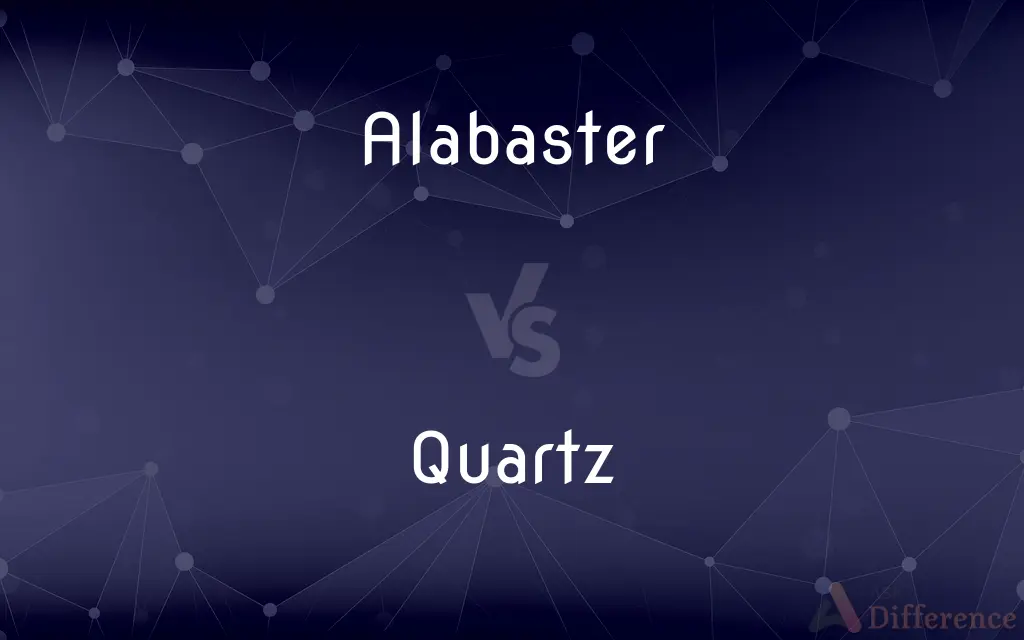Alabaster vs. Quartz — What's the Difference?
Edited by Tayyaba Rehman — By Fiza Rafique — Updated on April 2, 2024
Alabaster is a soft, fine-grained stone often used for carving and ornamental purposes, while quartz is a hard, crystalline mineral prized for its durability and varied colors.

Difference Between Alabaster and Quartz
Table of Contents
ADVERTISEMENT
Key Differences
Alabaster is known for its translucence and smooth texture, making it a preferred material for sculptures and decorative items. Its softness allows for intricate carving, yet it is less durable than many other stones. Quartz, on the other hand, is one of the hardest minerals on Earth, used in jewelry, electronics, and as a durable surface material in the form of engineered stone.
Quartz's composition includes a wide range of colors and types, such as clear, rose, and smoky quartz, due to impurities that add hues and character. Alabaster, while primarily white or lightly tinted, lacks the color variety found in quartz. This difference in appearance makes each stone suitable for different applications and aesthetic preferences.
The origins of alabaster and quartz also differ; alabaster is typically formed from gypsum or calcite, resulting in two types: gypsum alabaster and calcite alabaster, each with distinct properties. Quartz is a component of many rock types and forms under a variety of conditions, contributing to its widespread availability and use.
Durability is a significant factor distinguishing the two; quartz's hardness makes it resistant to scratches and wear, suitable for high-traffic areas in homes and commercial spaces. Alabaster's softer nature requires careful handling and placement in areas where it is less likely to be damaged.
While alabaster has been used throughout history for artistic and decorative purposes, quartz is valued for both its aesthetic qualities and its functional uses, including in quartz watches, which utilize its piezoelectric properties. This functional diversity underscores the broader applications of quartz compared to the more niche uses of alabaster.
ADVERTISEMENT
Comparison Chart
Composition
Made from gypsum or calcite.
Composed of silicon dioxide.
Hardness
Soft, easily carved.
Hard, durable, and scratch-resistant.
Colors
Typically white or lightly tinted.
Wide range of colors, including clear, rose, and smoky.
Uses
Artistic carvings, ornamental objects.
Jewelry, electronics, countertops.
Properties
Translucent, smooth texture.
Crystalline, varied in appearance due to impurities.
Compare with Definitions
Alabaster
A soft, fine-grained stone often white or lightly colored, used mainly for carving and decorative pieces.
The artist chose alabaster for the sculpture because of its translucency.
Quartz
A hard, crystalline mineral composed of silicon dioxide, widely used in jewelry and manufacturing.
Quartz countertops are popular for their durability and beauty.
Alabaster
Used historically in sculpture and ornamental architecture.
The medieval church featured alabaster panels along its walls.
Quartz
Hard and durable, available in various colors due to mineral impurities.
Rose quartz is favored for its soft pink hue in jewelry.
Alabaster
Known for its translucence and ability to be finely carved.
Alabaster vases are prized for their intricate designs.
Quartz
Resistant to wear and versatile in its applications.
Quartz is preferred for high-traffic areas in homes due to its hardness.
Alabaster
Requires careful handling to avoid scratches and damage.
The museum displayed the alabaster artifact in a glass case to protect it.
Quartz
Includes varieties like amethyst, citrine, and clear quartz, each with unique properties.
Amethyst, a type of quartz, is known for its vibrant purple color.
Alabaster
Comes primarily in two types: gypsum alabaster and calcite alabaster.
Gypsum alabaster was used extensively for small carvings in ancient Egypt.
Quartz
Applied in making jewelry, electronics, and as a construction material.
Quartz is used in watches because it maintains a precise frequency.
Alabaster
Alabaster is a mineral or rock that is soft, often used for carving, and is processed for plaster powder. Archaeologists and the stone processing industry use the word differently from geologists.
Quartz
Quartz is a hard, crystalline mineral composed of silica (silicon dioxide). The atoms are linked in a continuous framework of SiO4 silicon-oxygen tetrahedra, with each oxygen being shared between two tetrahedra, giving an overall chemical formula of SiO2.
Alabaster
A dense, translucent, white or tinted fine-grained gypsum.
Quartz
A very hard mineral composed of silica, SiO2, found worldwide in many different types of rocks, including sandstone and granite. Varieties of quartz include agate, chalcedony, chert, flint, opal, and rock crystal.
Alabaster
A variety of hard calcite, translucent and sometimes banded.
Quartz
(mineral) The most abundant mineral on the earth's surface, of chemical composition silicon dioxide, SiO2. It occurs in a variety of forms, both crystalline and amorphous. Found in every environment.
Alabaster
A pale yellowish pink to yellowish gray.
Quartz
Crystal meth: methamphetamine hydrochloride.
Alabaster
A fine-grained white or lightly-tinted variety of gypsum, used ornamentally.
Quartz
A form of silica, or silicon dioxide (SiO2), occurring in hexagonal crystals, which are commonly colorless and transparent, but sometimes also yellow, brown, purple, green, and of other colors; also in cryptocrystalline massive forms varying in color and degree of transparency, being sometimes opaque.
Alabaster
(historical) A variety of calcite, translucent and sometimes banded.
Quartz
Colorless glass made of almost pure silica
Alabaster
(color) An off-white colour, like that of alabaster.
Quartz
A hard glossy mineral consisting of silicon dioxide in crystal form; present in most rocks (especially sandstone and granite); yellow sand is quartz with iron oxide impurities
Alabaster
Made of alabaster.
The crown is stored in an alabaster box with an onyx handle and a gold lock.
Alabaster
Resembling alabaster: white, pale, translucent.
An ominous alabaster fog settled in the valley.
Alabaster
A compact variety or sulphate of lime, or gypsum, of fine texture, and usually white and translucent, but sometimes yellow, red, or gray. It is carved into vases, mantel ornaments, etc.
Alabaster
A box or vessel for holding odoriferous ointments, etc.; - so called from the stone of which it was originally made.
Alabaster
A compact fine-textured usually white gypsum used for carving
Alabaster
A hard compact kind of calcite
Alabaster
A very light white
Common Curiosities
Why is quartz preferred for countertops?
Quartz is preferred for countertops because of its durability, resistance to scratches, and wide range of colors.
Can alabaster be used outdoors?
Alabaster is not recommended for outdoor use due to its softness and susceptibility to weathering.
What are the different types of quartz?
Quartz has many types, including clear quartz, rose quartz, amethyst, and citrine, each distinguished by its color and properties.
How is alabaster carved?
Alabaster is carved using tools that allow for detailed work due to its softness, making it suitable for intricate designs.
What is alabaster used for?
Alabaster is primarily used for sculpture and decorative items due to its softness and translucency.
How do you care for alabaster objects?
Alabaster objects should be handled carefully, cleaned with a soft, dry cloth, and kept away from moisture to prevent damage.
What makes quartz suitable for electronics?
Quartz's piezoelectric properties make it suitable for electronics, as it can convert mechanical stress into electrical signals and vice versa.
Can quartz be used in jewelry?
Yes, quartz is widely used in jewelry for its beauty and variety of colors.
How does the care of quartz countertops compare to marble?
Quartz countertops require less maintenance than marble, as they are more stain-resistant and do not require sealing.
Are there color variations in alabaster?
Alabaster is primarily white or lightly tinted, lacking the extensive color variations found in quartz.
Is quartz natural or synthetic?
Quartz can be both; naturally occurring quartz is mined, while synthetic quartz is manufactured for specific applications.
What are the piezoelectric properties of quartz?
The piezoelectric properties of quartz refer to its ability to generate an electrical charge in response to applied mechanical stress.
What is the difference in hardness between alabaster and quartz?
Quartz is significantly harder than alabaster, making it more durable and resistant to scratches.
What historical uses does alabaster have?
Historically, alabaster was used for tomb monuments, church decorations, and small sculptures due to its workability and appearance.
Why might an artist choose alabaster over other stones for carving?
An artist might choose alabaster for its smooth texture, translucency, and ease of carving, allowing for detailed and delicate work.
Share Your Discovery

Previous Comparison
Amen vs. Amain
Next Comparison
Hijab vs. HijabiAuthor Spotlight
Written by
Fiza RafiqueFiza Rafique is a skilled content writer at AskDifference.com, where she meticulously refines and enhances written pieces. Drawing from her vast editorial expertise, Fiza ensures clarity, accuracy, and precision in every article. Passionate about language, she continually seeks to elevate the quality of content for readers worldwide.
Edited by
Tayyaba RehmanTayyaba Rehman is a distinguished writer, currently serving as a primary contributor to askdifference.com. As a researcher in semantics and etymology, Tayyaba's passion for the complexity of languages and their distinctions has found a perfect home on the platform. Tayyaba delves into the intricacies of language, distinguishing between commonly confused words and phrases, thereby providing clarity for readers worldwide.
















































